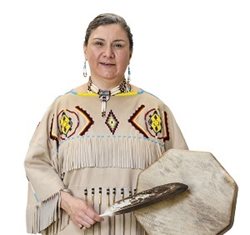 Major Shari Russell is territorial Indigenous ministries consultant for the Salvation Army. She’s part of a group of EFC affiliates who are discussing moving forward in reconciliation with Indigenous communities. We asked her to give us an update as part of our Three Questions Series of short online interviews.
Major Shari Russell is territorial Indigenous ministries consultant for the Salvation Army. She’s part of a group of EFC affiliates who are discussing moving forward in reconciliation with Indigenous communities. We asked her to give us an update as part of our Three Questions Series of short online interviews.
Shari is a Saulteaux woman from the YellowQuill First Nation in Saskatchewan, “scooped” like many Indigenous children at the time from her birth home and eventually adopted into a Salvation Army family. She and her husband have been officers in the Salvation Army for many years.
Q1. You were part of some recent gatherings in June to talk about Indigenous-Settler relations. Can you tell us what those were about?
The EFC in October 2017 hosted a denominational gathering on reconciliation in Winnipeg. [Editor’s note: read some reflections on that event by Wendy Peterson.]
At this gathering, many participants referred to NAIITS: A Learning Community (an institution formerly known as North American Institute for Indigenous Theological Studies). It became clear participants shared a desire to learn from Indigenous peoples and share their knowledge and experiences within a theological framework. NAIITS holds an annual symposium in a different Canadian location each year.
The most recent NAIITS symposium was in June 2018 in Wolfville, N.S., at Acadia Divinity College. It was focused on “White Supremacy, Racial Conflict, and Indigeneity: Towards Right Relationship.” Presenters from around the world (New Zealand, Australia, North America) spoke about the impact of white supremacy, colonization and patriarchy within the Christian faith.
Recognizing and realizing the prevalence of dominant white culture facilitated honest reflection and open discussions as participants had opportunity to discover life experiences from perspectives much different than their own. [Editor’s note: Read more reports on the symposium from Canadian Mennonite, Salvationist and EMCC. Here's a quick intro video about NAIITS.]
Q2. After the NAIITS symposium, the smaller EFC gathering met to share highlights and significant reflections on their learning. How did that go?
This small group recommended attending the next symposium in 2019 at Tyndale University and Seminary in Toronto as a continuation for learning and sharing together. There was affirmation on steps already articulated such as a “clearing house” to share resources such as “Strength for Climbing” developed by KAIROS Canada. Other potential steps for collaboration include a newsletter highlighting new resources and events, working together to host events to promote right relationship, and resourcing churches with specific protocols.
A key concept from the symposium which resonated deeply with many was the connection between the concept of Treaty and the biblical concept of Covenant with its connection to right relationships with Indigenous peoples. A conversation for further dialogue and learning on this key concept was recommended with the potential formation of a working group who will promote study on what it means to be treaty people.
Q3. What are your hopes for future activities connected to this group of EFC affiliates?
Reconciliation is a process, and it is imperative the church engage in this as we are called to be ministers of reconciliation. This concept of reconciliation often centres around individuals and God but neglects the essential response of right relationship with one another as participants in the work of God in the world. The church’s culpability in colonization not only needs to be acknowledged, but the church needs to courageously engage in the Calls to Action set out by the Truth and Reconciliation Commission.
As we continue to gather, it is my hope that local churches will see their responsibility in resetting this relationship and engage wholeheartedly in this process of working towards right relationships with Indigenous peoples in this land, understanding that these relationships become tangible evidence of the hope that we profess.